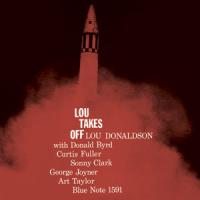Pricey Lou Donaldson Original Comes Down to Earth on Classic Reissue
The idea of this 1956 session was for everyone involved to have a chance to blow the roof off Van Gelder's home recording studio. And why not when you have trumpeter Donald Byrd and trombonist Curtis Fuller joining the alto sax player's group for this session, with Sonny Clark on piano backed by drummer Art Taylor and George Joyner on bass?
The set jumps from the second the stylus hits the grooves, with the breakneck “Sputnik,” an extended piece built upon a simple, stuttering bop line. Next up is Parker's “Dewey Square,” with everyone again stepping up to the mike for a series of hairpin-turn solos that will get your adrenalin pulsing.
Side two opens with the bluesy “Strollin' In,” a mid-temp Donaldson original that snakes its way through another series of long, generous solos, including funky, introspective one from bassist Joyner. The set closes with Dizzy's familiar “Groovin' High,” again taken at a fast clip with lockstep doubling by Donaldson and Byrd on the main theme.
Any doubts that jazz is America's classical music will be quickly dispelled by listening to an album like this. It's a superb sounding Van Gelder recording that captures the brass of Donald Byrd's trumpet and Curtis Fuller's trombone with particular grace and dazzling grit.
The “stereo” recording puts Donaldson, Fuller and Byrd hard left, the rhythm section hard right and Sonny Clark's piano dead center or slightly to the left thereof. In other words, this was Van Gelder recording live to two-track with the intention being to use the rhythm section/lead instrument separation as a means to get an ideal post-session blend, not for release as a “stereo” recording. Nonetheless, with the advent of stereo records, Blue Note issued the set that way along with the mono.
Classic's reissue comes in both sonic flavors. In either version, you get a 200g slab with a 'deep groove' label and superb outer packaging. It's as close to having an original physically as you can get without shelling out big bucks for an original-if you can find one.
The “stereo” recording relies upon a healthy dosage of added reverb to create a semblance of a coherent soundstage, and while it is enticing, it tends to make the instruments bigger than life and more harmonically vivid than in reality.
The mono mix is a tighter, more precisely focused assemblage. There is still audible reverb behind each instrument-particularly Fuller's trombone-but with everything emanating from a central plane, the delayed field is less obtrusive and doesn't tend to increase the size of instruments as much as the size of the soundfield around them. However, the stereo mix is richer sounding overall, while the mono sounds brighter, thinner and curiously recessed in the midrange, which is not what original Blue Note monos sounded like. Still, good luck finding an original Blue Note mono in clean shape for a reasonable amount of coinage. If you have a mono cartridge, definitely get the mono. Otherwise, get the mono.
That vinyl of this quality is still coming our way in 2005 is nothing short of miraculous.



